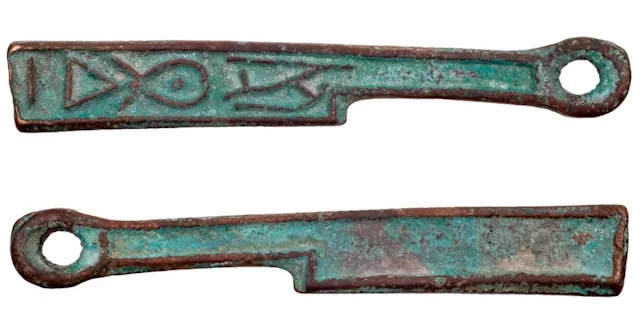The invention of currency is a phenomenon that still cannot be stated with absolute certainty without incurring minor errors or omissions. Attributing its creation to a single person or civilization would be imprecise, as its emergence resulted from a long process of maturation in commercial transactions between individuals and peoples.
One of the most well-known theories attributes the beginning of coin minting, as we know it today, to China. During the Zhou period (1122-256 BC), bronze coins appeared in various shapes, such as fish, keys, knives, shells, and even hoes. These shapes were inspired by goods and objects that had exchange value and bore inscriptions indicating the issuing authority and their worth. Toward the end of this dynasty, monetary gold (Yuanjun) emerged, minted in the form of small ingots with the imperial seal. It was also during this period that the first round bronze coins with a square hole in the center appeared, characteristics that persisted for centuries in the Chinese monetary system.
The Chinese people are undoubtedly the creators of paper money, which would be consolidated centuries later during the Tang dynasty (618-907 AD) and widely disseminated during the Song dynasty (960-1279 AD).
In Ancient Greece, another monetary tradition developed. From the 7th century BC onward, coins began to be minted with depictions of animals, plants, and everyday objects. Some of the most well-known coins from this period featured the owl, Pegasus, and the turtle.
Turtles were the first Greek coins to be minted. The oldest specimens date back to approximately 625 BC, and for a century, they were the most valued coins in the region, representing the island of Aegina, an important commercial hub in the Peloponnesus. These coins were highly valued and appreciated more than owls, as they were worth two drachmas (with the drachma being a unit of silver currency).
Staters, minted in Corinth, were identified by the image of Pegasus and could be made of silver or gold. The stater was one of the highest monetary units in Greece.
Owls, minted in Athens, had less value compared to the coins of Aegina and Corinth, being worth one drachma or a stater. Around 545 BC, Athens minted the tetradrachm, a splendid coin worth four drachmas, which remained virtually unchanged for nearly two centuries. After the Athenian victory over the Persians at the Battle of Salamis (480 BC), the decadrachm was introduced, a coin worth ten drachmas.
Another important theory attributes the invention of coinage to the kings of Lydia, in the region of Anatolia. The earliest Lydian coins were small and rounded, minted from a natural alloy of gold and silver known as electrum. The obverse featured the image of a lion’s head, while the reverse bore a mark guaranteeing the issuer. King Croesus (561-546 BC), one of the wealthiest monarchs of antiquity, pioneered the minting of coins exclusively in gold and silver, establishing a monetary standard that would influence many later civilizations. With Lydia's conquest by the Persians, King Darius I (550-486 BC) adopted the Lydian monetary system and introduced darics, gold coins featuring the king holding a bow and a scepter, as well as silver siglos, both widely used throughout the vast Persian Empire.
The truth is that there is no absolute consensus on which civilization minted the first coin. Each region developed its own monetary system independently or through the influence of commercial and cultural exchanges. Thus, we continue to explore the various known perspectives on this fascinating history.
.png)



![[BR] Estados de conservação das moedas para classificação](https://blogger.googleusercontent.com/img/b/R29vZ2xl/AVvXsEgngHUbwbzQWgdpvGFsGk6Nrt0Go6jxcbHKC6V5SDagFKlXkXHss9q5-kDv25wU77PANGSBYEV4x2WjDUp36rXXea6fqEto7nrwXlkC61oKkLfgDJA_VWVWAs3y0T2Xh2Ycjfyb9mXm3DFPGD7S4h-8xJ3-Afgd88EJsTK8dCNpGWh0nxyyFqcmMevYDGg/w72-h72-p-k-no-nu/grading-scale.webp)
![[BR] Moedas raras despertam interesse e giram R$ 31 milhões](https://blogger.googleusercontent.com/img/a/AVvXsEikjc_mN6_3Oxkxi7yuMq84iwOdHmFPtJ87IAep_XZAAU877yon-_hYI-yDDJvHnF8P_ZhUz_xSn_bgl1Ik8wUFWbtIZ-Oh7hb3C2GPg0ySDGRgxvDhgQB-vNb14Ik9yg71TehGQSdJt7_Mzr_DFGjC6YFiwD3D-Ei0OGo0eCOLBpls5Zmfcdsv4ysgCt0=w72-h72-p-k-no-nu)
![[BR] Homenagem do CFB à Francisco Carlos de Araújo Brusque](https://blogger.googleusercontent.com/img/b/R29vZ2xl/AVvXsEjiiDp7QXyUO8_0EPynUiS6EOaWFAX7ztqd_1Xloaqi9uPSAjHQk8juCylId_u9O38HS45LVY997Dt_zZsf2DkX4iqLQWu6KUrtxHSWgtKlzO6jToNA1_Pd12rNVKcuVhNoAkXJpRcoh4Foy-IPsIaVhBlkvXFs1eWvYcRPNeBQ9_SiB8pP52YrXpjaOEw/w72-h72-p-k-no-nu/111.jpg)
![[EN] BC reused banknotes before launching the R$200 note.](https://blogger.googleusercontent.com/img/b/R29vZ2xl/AVvXsEhUq4eYbc4RMt5XC1nGZCR3e2o_cFzEaRQUt3LWe646UKxpObeYsaZwt2vY628Fd7fH1WcPtp60YiH-FMtoItjzQ-Yc-epPAFC3WanL9aZcNZ397MHN1cWo2u54LYn9q8HJyKv_onOM5ClTt_I-aAwYr0QJeo9EQYSyaNulaS1v0-8fWrfJb074f6r_UUA/w72-h72-p-k-no-nu/Sem%20t%C3%ADtulodasdas.jpg)

0 Comentários